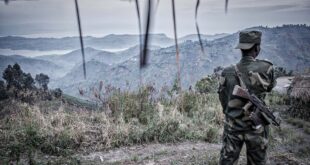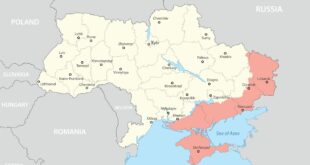Since August 1, when President Barack Obama announced the start of an air war against the Islamic State (ISIL) in Libya, the United States has conducted a total of 57 air strikes, most involving close air support for Libyan militia forces, ostensibly loyal to the United Nations-imposed Government of National Accord (GNA). The US air war, dubbed “Operation Odyssey Lightening,” involved precision strikes against ISIL targets, largely inside the city of Sirte, along with intelligence, surveillance, and reconnaissance (ISR) operations. Pentagon officials said that the air war, conducted out of Italy as well as drone bases in Jordan, will last “weeks, not months.”
But that promise of a limited time duration may prove to be naïve. The Islamic State is, indeed, on the verge of losing its entire base of operations in the vital coastal city of Sirte, which it first took nearly two years ago. This week, the Misurata militias, which have conducted the bulk of the ground war against ISIL in Sirte, announced that key center city facilities had been taken from ISIL, and there are only an estimated 150-200 Islamic State fighters believed to be still holed up in Districts 1 and 3 of the city. Since the Misurata militia launched the ground operations on June 9, the group has reported 300 deaths and 1,800 injuries among its fighters.
Of the estimated 4,000-6,000 ISIL fighters in Libya, a vast majority have abandoned Sirte or been killed in the fighting. Most are now fleeing south, to link up with ISIL-affiliated groups in Algeria, Niger, Sudan, and Nigeria, including Boko Haram. Another contingent of ISIL fighters are moving across the porous border into Tunisia.
In a further re-deployment, an unknown number of ISIL fighters have joined the floods of refugees crossing the Mediterranean into Italy. US intelligence, working with the Libyan GNA, have concluded that a significant cell of Islamic State terrorists has arrived in Milan, Italy. The GNA issued a warning to Italian authorities last week, about the existence of an ISIL cell in Milan, based on documents confiscated in the takeover of the major convention center in the center of Sirte, which had been the Islamic State’s headquarters until it was recently overrun.
The Milan cell was linked to one of the leaders of ISIL in North Africa, the Tunisian known as Abu Nassim (birth name, Moez Ben Abdelkader Fezzani). Nassim lived in Italy from 1989-1997, when he went to Afghanistan to join al-Qaeda. He was captured by the Americans and briefly held at Bagram Air Base, before being shipped back to Italy. Italian authorities eventually sent him to Tunisia. He escaped from there to Syria, joined the Islamic State and was later named by Abu Bakr al-Baghdadi as the head of ISIL operations in the Tunisia-Libya border area, centered at Sabratha in western Libya.
The Milan cell was promoted by Tunisian cleric Hosni Hachemi Ben Hassem, who was recently deported, along with over 100 other suspected ISIL and al-Qaeda operatives and sympathizers back to Tunisia and other home countries.
Last week, General Khalifa Haftar, the head of the self-named Libyan National Army, announced that Zintani tribal forces, allied with his Operation Dignity forces, captured Abu Nassim, along with 20 other ISIL fighters, as they attempted to cross into Tunisia. Abu Nassim was recently named as the most wanted criminal by the Tunisian authorities for his role in the March 2016 Ben Guerdane massacre in eastern Tunisia near the Libyan border. If Haftar’s claim is accurate, it will be another blow to ISIL, but it could have other consequences as well.
For the past year, the fight against the Islamic State in Libya has taken precedence over the infighting among rival militias. The GNA is, by all accounts, a weak factor, dependent on various militia coalitions to maintain an appearance of power in Tripoli. The real power struggle is between the Misurata militias, which have aligned with the GNA’s Prime Minister and Chairman of the Presidential Council Fayez Sarraj; the Petroleum Facilities Guards, a rival militia that has also on occasion aligned with the GNA; and the Libyan National Army of General Haftar, which is backed by the parliament-in-exile in Tobruk in eastern Libya. Prominent cleric Sadiq al-Ghariani is also a rival in the ongoing power struggles, and he has denounced Prime Minister Sarraj for inviting the American air force to operate in Libya.
While the United States has given its conditional support to the GNA and Prime Minister Sarraj, Washington has also made no effort to discourage Egypt and France from providing substantial support to General Haftar. The GNA has denounced France for allowing French Special Forces to work directly with Haftar’s Operation Dignity. During the week of August 8, Sarraj’s Vice-Chairman Ahmed Maiteeq was in Cairo, meeting with the Egyptian Foreign Minister Sameh Shoukry, in an effort to forge an agreement between the GNA and Haftar. The meeting failed to achieve any breakthrough, although diplomatic talks will likely continue.
For the United States, Haftar has been a long-serving asset, dating back to his prolonged stay in the United States and his return to Libya in the 1990s to attempt an aborted coup against Qaddafi, staged out of Chad. When the “revolution” began in 2011, Haftar was sent back again to Libya. Now, Washington is striking a delicate balance, between support for Haftar and for the GNA, to make sure the general is not strong enough to carry out a successful coup and emerge as a new strongman.
The only source of positive movement on the internal reconciliation front came August 19, when a Greek-flagged oil tanker, the New Hellas, docked at the major east Libya oil port of Zueitina, and took delivery of 600,000 barrels of crude oil that was the first installment of 3 million barrels of stored crude that will be brought to the refinery at Zawiya in western Libya for refining and eventual sale on the world market. The Zueitina facility was opened as part of an agreement between the Libyan National Oil Company, the Petroleum Facilities Guards and Haftar’s Libyan National Army. The GNA has staked its survival on the ability to reopen Libya’s petroleum sector. Ironically, the small trickle of new Libyan oil onto world markets was enough to drive down oil prices once again, according to a Washington-based monitor of the world petroleum markets.
Despite this tentative step of opening the Libyan oil ports to tankers, the situation will remain extremely divided and fragile for some time. With the expected full ousting of ISIL from Sirte, the group will likely accelerate its terrorist operations, to conceal the fact that they suffered a significant defeat. Last week the GNA announced that they had foiled an Islamic State assassination plot against Sarraj, and arrested the ringleader Abu Moaz al-Ansari.
The ouster of ISIL from Sirte will intensify the factional fighting among the rival groupings. The Misurata militias will demand a significant share of power, based on their victory—with heavy US air support—in Sirte. Haftar will use his partial control over the vital oil ports in eastern Libya as his main bargaining chip, along with his alliance with the Zintana tribal militias which captured the top ISIL leader in the region.
If anything, the defeat of ISIL in Sirte begins a new chapter in the Libyan power struggle, with regional and international actors’ involvement adding a further complication. A series of spectacular terrorist attacks by ISIL cannot be ruled out in the immediate days and weeks ahead, and this will only intensify the power struggles that have been building since the ouster of Qaddafi in 2011.
Washington’s balancing act — supporting the GNA and the Misurata militias as well as their chief rival, General Haftar — will do little to advance the cause of Libyan stability.
 Geostrategic Media Political Commentary, Analysis, Security, Defense
Geostrategic Media Political Commentary, Analysis, Security, Defense





